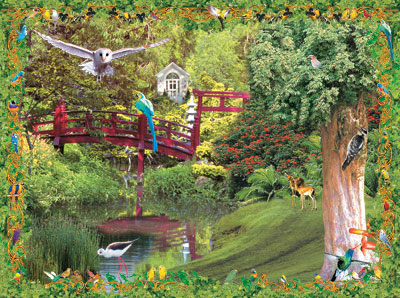Introduction
According to one of the evolution scenario’s claims, some water-dwelling amphibians developed into fully, terrestrial reptiles. One branch of this group evolved further, constituting the ancestors of today’s birds.
According to evolutionist claims, these imaginary creatures descended from their alleged reptilian ancestors some 150 to 200 million years ago, acquiring new characteristics gradually and in stages until they emerged as fully-fledged birds. As this scenario requires, their attempts at flying also emerged in stages before taking on its presently flawless ability.
However, despite all the efforts expended over the last century and a half, not a single trace has ever been found of the half-bird, half-reptile creatures that evolutionists assume must once have lived. No transitional forms covered half in scales and half in feathers, or with half-developed wings, have ever been found in the Earth’s geological strata. In fact, contrary to what’s been conjectured, only fossils with perfect structures—the remains of flawless, fully formed living things—have ever been discovered.
But despite the absence of any evidence to support their unscientific tale, evolutionists doggedly persist in their claims, hoping that these fictitious fossils will one day be found. Their evidence for their impossible dreams go no further than outright distortions and biased interpretations of the facts, as you shall see in detail in the following chapters.
There are more than 10,000 species of birds on Earth, each of which possesses its own unique features. Hawks have very sharp eyes, broad wings and pointed talons. Their eyesight is so keen that they can make out a baby rabbit on the ground from hundreds of meters up in the air.
Plovers, weighing just a few hundred grams, flap their wings for 88 hours non-stop on the journey of 4,000 kilometers (2,485 miles) that they make every winter, crossing the ocean without mishap.
 |
| There are more than ten thousand species of birds, each of which possesses markedly different features. Owls, parrots, woodpeckers, crows, hummingbirds. Each of these species, from ostrich to swallow, is an example of Allah’s creative artistry and, its attributes display His infinite knowledge. |
With their ability to imitate sounds including human speech, parrots are among the cleverest of living things. Although anatomy of their mouths is wholly different—they have no teeth or lips, for instance—they are able to produce sounds very similar to those they hear.
With their long beaks, the hummingbirds—the smallest known species of birds—can feed on flower nectar and the small insects they find inside flowers. In order to feed, they need to hover in the air in front of the flower, and with its specially created features, they are the only species of bird able to do so.
The owl, thanks to the special creation in its soft but rounded feathers, hunts its prey at night in complete silence. Thus the owl’s wing, which prevents air turbulence—and thus, noise—has taken its place among the designs that scientists are seeking to replicate.
The albatross, whose wing span of 3.5 meters (11.48 feet) is the largest in the world, spends 92% of its life over the open sea, almost never alighting on solid ground. Albatrosses’ almost constant state of flight is made possible by their use of air currents, as they open their wings out as far as possible, without flapping them.
Jays bury the bonito fish they collect for later use. With their powerful memories, they are able to find and extract these fish even after nine months have passed, in forests where every tree resembles every other.
The way that birds show devoted behavior towards their young is also most striking. Some birds construct highly intricate nests, taking account of a great many factors during their construction. Birds living by the seashore, for example, build nests that cannot be flooded, using the appropriate materials for this. They even calculate how their future young should come to no harm in the event that water levels rise. Some marsh-dwelling birds build nests with high walls so that their eggs cannot be blown out by the wind.
How are such different types of nests, intelligent behavior and altruism, whose variety would fill many volumes, possible for these creatures, which are totally without reason or training?
It is impossible for them to have gradually developed the features they possess, because they could not have survived during the intermediate stages of any such process. Indeed, no creature has ever grown to perfection in stages, as evolutionists would have us believe. On the contrary, all different living groups have existed in their current perfect states ever since they first appeared in the Earth's geological strata.
This is scientific evidence that birds too were created, and this evidence represents a truth taught to human beings in the Qur'an: it is Allah, the Creator of all things, Who created these creatures with all the features they possess and the systems appropriate to them.
In verses, Allah reveals His dominion over the living world:
“. . . There is no creature He does not hold by the forelock.” (Surah Hud, 56)
The flawless features possessed by birds are just a few examples of the knowledge and artistry of Allah, the Lord of the Earth and sky:
“. . . The kingdom of the heavens and the Earth and everything between them belongs to Allah. He creates whatever He wills. Allah has power over all things.” (Surat al-Ma’ida, 17)
- Foreword
- Introduction
- Evolutionist Scenarios and Dilemmas Regarding the Origin of Flight
- Important Structural Differences Between Dinosaurs and Birds
- Archaeopteryx is an Extinct Species of Bird, Not an Intermediate Form
- The False Fossil Archaeoraptor: An Example of Evolutionist Fanaticism
- Imaginary Dinosaur-Bird Links
- Pterosaurs - A Dilemma for the Theory of Evolution
- The Origin of Flight in Insects
- Conclusion
